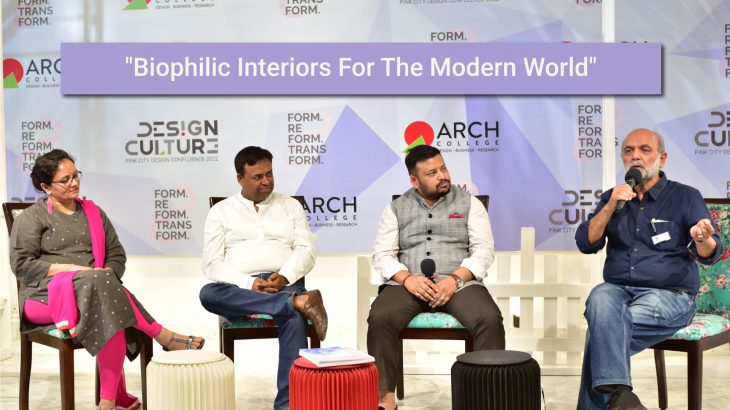Biophilic design is not just a word that signifies the true essence of being a nature lover; rather it brings together natural and scientific features into creating both sustainable and healthy design techniques for future benefits of our living. Biophilic design is a concept that brings life to our interior spaces and reduces anxiety. Biophilia is not something to be forced on as when we force something on our surroundings some consequences overshadow its benefits. Therefore, it is necessary to understand the need for space and read the hidden silences to provide higher quality benefits. This session at ARCH College of Design and Business helps one understand the basics of biophilia and biophilic design in architectural and interior spaces therein.
About speakers and their thoughts on the topic:
Mr Sheetal Kumar Agrawal is the Chairperson of the Institute of Indian Interior Designers – JRC. He talks about how covid has added some enhanced highlights to this concept as it motivated people to get fresh and more oxygen, natural light and an eco-friendly environment from head to toe. The concept of Biophilic Design means integrating nature within your interior living spaces. It not only adds beauty to your interior but also provides a healthy environment for one to live in, which is an extremely vital condition nowadays. He also perfectly demonstrates that understanding the meaning of biophilic design is easier than everybody can understand. However, the technique to incorporate it into our design is the tricky part upon which designers should work.
Nikhil Agrawal, Design Atelier’s Chief Architect. Design Atelier is a multidisciplinary design practice whose work seamlessly weaves interior and exterior spaces, from large architectural ideas to the smallest of furniture details. He talks about bringing the similarly pleasurable experience of the unconscious mind that we enjoy when visiting mountains, forests or beaches to our homes with a little planning and significant execution. It facilitates adaptation and a better state of your mind. Nowadays people want to change their furniture and lifestyle to be easily movable instead of fixing it as per the need. The use of organic materials is the best way to gain knowledge and should be in the curriculum of the path toward Biophilia. Usage of locally available stuff and material for building a biophilic design is really necessary as you need to be fully natural and not just superficially.
Megha Bhatnagar is an Architect at Archeus Design Studio who focuses on Architectural projects which put stress on eco-friendly options such as water conservation, sustainability and ecology. She talks about how biophilic design is not bound to be a specific subject, it is something that is built into the design by yourself with your beliefs naturally. This concept can have different meanings for different people but for her, it is like grammar to her as you learn it simultaneously. She speaks about how Biophilic Designs add flavours to the interior and also about how keeping plants is not being biophilic; it should be from both within and outside to produce evergreen results. Therefore, designers should be conscious of totality to understand the new space and its voice thoroughly. Sustainability, reuse, and reprocess are some ways by which you can start indirectly respecting nature. Biophilia is a healing method for many.
Moderator of the session: Bhargav Mistry, Dean, Design Culture, Arch College of Design and Business. Bhargav Mistry has an extensive experience of almost four decades in the profession and pedagogy of design. As a moderator, he first introduced the meaning of Biophilia by etymological dissection of the word – Philia in Greek means love for something and Bio, meaning Nature. His incisive and thought-provoking questions to the panellists steered the conversations into intensely absorbing and meaningful dialogues. He cited examples for discussion by mentioning that the older generation, without knowing the word ‘biophilia’, had integrated nature within interior spaces. It’s the modern-day architectural methods that have alienated it from being a part of living. He also initiated the discussion on how to understand the silent needs of nature by being empathetic not only to humans but to nature at large.
A final word as expressed by the moderator:
Biophilia is something that teaches you the importance of this space and the environment around you. It ensures that you respect your surroundings and not just go with the trend and misuse the essence of biophilic design. It is a complete mix of modernized and ancient traditional ways to represent nature in the global arena. It is a type of culture that needs to be inculcated as a habit within every individual to establish something with greater meaning and future outcomes. Biophilic design is not just limited to having green plants inside the house, it has a larger perspective by including natural air purifiers, eco-friendly fabric living walls and many more. Therefore to learn and understand more about the topic, one can visit the YouTube channel of the ARCH College of Design and Business.
